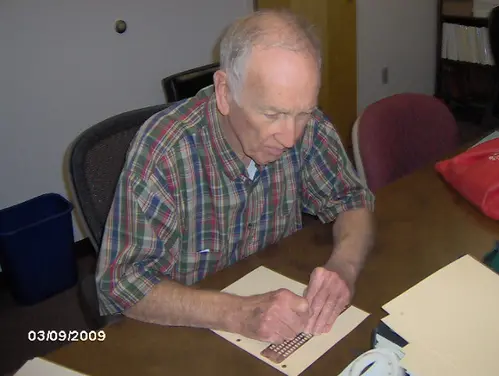One of the most focused clients I ever have had the pleasure to serve has been Sylvan Dawson, of Marion. A retired engineer from Rockwell-Collins, Sylvan had had visual problems since his childhood, when retinitis pigmentosa (RP) first was diagnosed. Though the disease's progression was slower than usual, he had experienced night blindness and narrowed visual fields since his teens, he gave up night driving in his 30s, stopped driving altogether at age 49, and retired from his job at 59.
In a pattern quite normal for people with RP, he put off the reckoning with blindness up to the point where there was virtually no vision left to use. At age 77, with only light perception left, he was left with two basic choices: 1) depend on others to accomplish things that he once did with vision, or 2) learn non-visual "alternative techniques" to compensate for loss of vision.
Fortunately for his wife, Mary Ann, and himself, he chose the latter.
We met, and soon I found that Sylvan had devised several non-visual ways of doing everyday tasks on his own. He was sorting his medications by size and shape of pills. He was getting around his home by feel and by memory. However, he wanted to do more than just exist around home.
In the short term, I introduced him to tactile methods of identifying money and folding bills, and checked on such things as whether he could set common appliances on his own (he could). He had a long white cane and basic knowledge of how to use it, and wasn't seeking more instruction, but Sylvan soon made known his two main concerns. He wanted to learn Braille to the point that he could use it for labels and notes and, most importantly for him, he wanted to have access to his computer.
We set up an Independent Living rehabilitation case in order to achieve these goals. We started with Braille, and Sylvan had most of the alphabet mastered before he and Mary Ann headed south for the winter. He completed the Braille shortly after returning to Iowa in March, and since then has found it particularly helpful with labeling items around the home.
Even though his progress in Braille wasn't shabby in the least, it was clear that Sylvan's primary interest was in the computer. I introduced him to the screen-reading program JAWS and how Windows can be navigated completely by use of keystrokes, and it was obvious that he was doing much work on his own. Before long he was working successfully in Word, Excel, email and Internet, but somewhere along the way he had found out about JAWS' main competitor, WindowEyes. I gave him a demo disk, and he thought that product's tutorials were clearer than those for JAWS, so he decided to purchase WindowEyes.
Shortly after this, Sylvan participated in one of our biennial Senior Orientation sessions in Des Moines. This was useful in many ways. He had not had much contact with other blind people up to that time, and found that beneficial. Even though his interests didn't gravitate much toward cooking or cane travel, he came out of the experience appreciative of things he had learned in those areas. And in his computer class he was able to work with Mike Barber, who (unlike me) had good working knowledge of how WindowEyes works, enabling Sylvan to make a giant leap forward in his knowledge and facility with that new system.
Once back in Marion, Sylvan had a solid understanding of how to operate his computer with his screen reader, and whereas he had been reluctant in the past to take chances or initiative on the computer, now he was doing so without being prompted. Despite this, he continued to have trouble dealing with some web sites, especially one he used for tracking investments. Between the two of us we were able to determine patterns of organization that finally allowed him access to a site that didn't speak all of its elements and wasn't classically accessible.
In his quiet way, Sylvan continues to use the skills he learned. In his summation of his experiences with training, he stated: "Jonathan Ice was a big help to me in learning to use Braille, library services, getting me to the one week session in Des Moines in September 2009. The most important result of the training was learning to use the computer again with Jonathan's valuable assistance. It would have been very difficult without his help."
While it is gratifying to receive such an appreciative review, I must shift the responsibility for progress back where it mostly belongs – to Sylvan. We at the Department for the Blind bring services that can foster independence, but they are to little avail without client buy-in, and Sylvan did that in a big and mutually beneficial way.
-- Jonathan Ice
Independent Living Teacher
